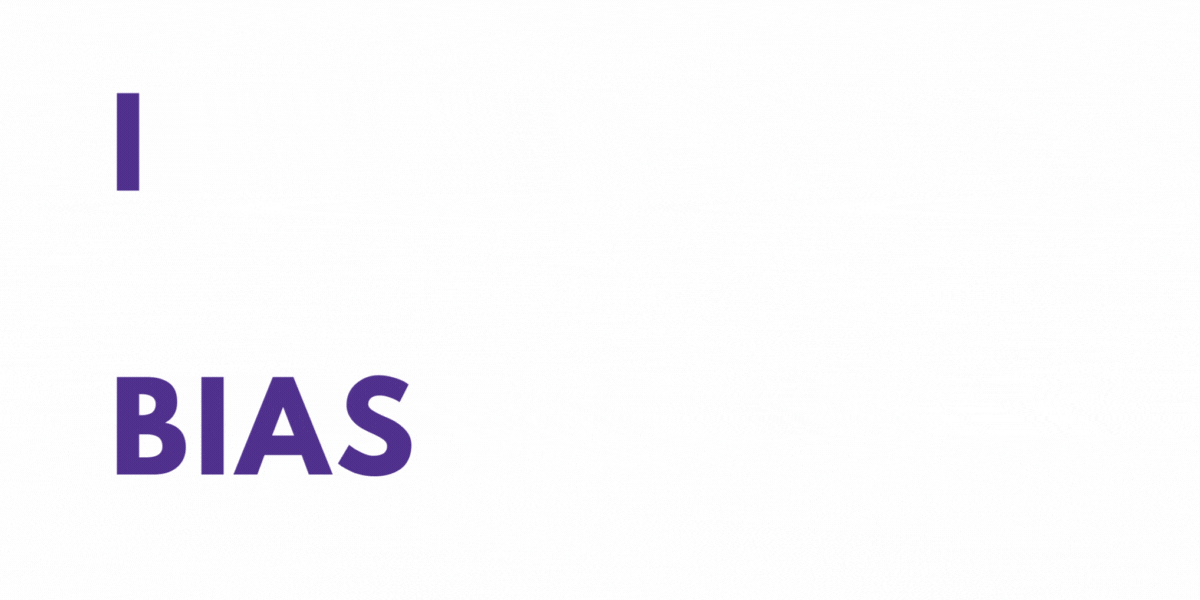
IBIAS is still launching. Stay tuned for more details.
Implicit bias among nurses is an urgent patient safety issue. Despite decades of evidence showing that bias among healthcare professionals contributes to health disparities impacting numerous marginalized communities,1-10 disparities remain and, in some cases, worsened.11
To effectively address bias in health care, a culture shift is first required to normalize that every person has bias despite our best intentions, and—like medication errors—it is not a matter of ‘if’ but ‘when’ bias impacts nursing care.
Behavior change in care settings is needed to mitigate the effects of bias on nursing care and IBIAS™ was developed to do just that—interrupt bias in health care environments.


- Be aware of how implicit bias may impact the care they and others provide, and
- Implement bias-interrupting skills every time they provide care once they enter the workforce.
After participating in IBIAS™ throughout their clinical education, students will be able to:
- Define and contrast health equity terms;
- Recognize how frequently all individuals make incorrect automatic assumptions about others;
- Articulate how implicit bias among nurses can negatively impact care provided, including how it can contribute to preventable patient death;
- Explore potential sources of own implicit bias;
- Demonstrate two of ten bias-interrupting skills while providing nursing care during each clinical learning day; and
- Determine when assumptions without evidence are made by self, others during each clinical learning day.
WHY should organizations implement IBIAS™?
- Substantial research reveals that implicit bias among nurses and other health care professionals contributes to poorer health care experiences, outcomes, and increased morbidity and mortality for numerous marginalized groups including BIPOC and LGBTQ+ communities, those who are larger-bodied, older, have lower socio-economic status, substance use disorder, are unhoused, and others.1-10
- In addition to enormous human costs, preventable health disparities based on race, ethnicity, gender, and socioeconomic status alone are estimated to cost US taxpayers and companies between $320 billion and $986 billion per year.19-20 New regulations stipulate that health systems must take actions to address health disparities to meet safety goals, maintain accreditation, or receive full CMS funding.21-24 Addressing bias among health care professionals should be part of these efforts.
- National organizations and new accreditation and legal requirements25-32 recommend or stipulate that nursing education programs must teach nursing students how to interrupt implicit bias in patient care settings (e.g., new AACN Essentials, Future of Nursing 2020-2030 report, Washington State Bills 5227 & 5229).
HOW is IBIAS™ different than other approaches?
No program currently exists that effectively teaches health professions students skills to interrupt bias in care settings.9,10,33 IBIAS™ addresses this urgent gap and fulfills many of these new state and national requirements while supporting the American Nurse’s Association’s and International Council of Nurse’s Code of Ethics, and the mission, vision, and values of many schools of nursing.34-35
References
- Institute of Medicine (US) Committee on Understanding and Eliminating Racial and Ethnic Disparities in Health Care, Smedley BD, Stith AY, Nelson AR, eds. Unequal Treatment: Confronting Racial and Ethnic Disparities in Health Care. Washington (DC): National Academies Press (US); 2003.
- van Ryn M, Burgess DJ, Dovidio JF, et al. THE IMPACT OF RACISM ON CLINICIAN COGNITION, BEHAVIOR, AND CLINICAL DECISION MAKING. Du Bois review : social science research on race. 2011;8(1):199-218.
- Hall WJ, Chapman MV, Lee KM, et al. Implicit Racial/Ethnic Bias Among Health Care Professionals and Its Influence on Health Care Outcomes: A Systematic Review. Am J Public Health. 2015;105(12):e60-e76. doi:10.2105/AJPH.2015.302903
- FitzGerald C, Hurst S. Implicit bias in healthcare professionals: a systematic review. BMC Med Ethics. 2017;18(1):19. doi:10.1186/s12910-017-0179-8
- Pont SJ, Puhl R, Cook SR, Slusser W. Stigma Experienced by Children and Adolescents With Obesity. Pediatrics. 2017;140(6):e20173034. doi: 10.1542/peds.2017-3034.
- Maina IW, Belton TD, Ginzberg S, Singh A, Johnson TJ. A decade of studying implicit racial/ethnic bias in healthcare providers using the implicit association test. Soc Sci Med. 2018; 199:219–29. doi:10.1016/j.socscimed.2017.05.009
- Nafiu OO, Mpody C, Kim SS, Uffman JC, Tobias JD. Race, Postoperative Complications, and Death in Apparently Healthy Children. Pediatrics. 2020:e20194113. doi: 10.1542/peds.2019-4113.
- Eisenberg, ME, McMorris, BJ, Rider, GN, Gower, AL, Coleman, E. “It’s kind of hard to go to the doctor’s office if you’re hated there.” A call for gender‐affirming care from transgender and gender diverse adolescents in the United States. Health Soc Care Community. 2020; 28: 1082– 1089. doi:10.1111/hsc.12941
- Groves PS, Bunch JL, Sabin JA. Nurse bias and nursing care disparities related to patient characteristics: A scoping review of the quantitative and qualitative evidence. J Clin Nurs. 2021;30(23-24):3385-3397. doi:10.1111/jocn.15861
- Vela MB, Erondu AI, Smith NA, Peek ME, Woodruff JN, Chin MH. Eliminating Explicit and Implicit Biases in Health Care: Evidence and Research Needs. Annu Rev Public Health. 2022;43:477-501. doi:10.1146/annurev-publhealth-052620-103528
- Agency for Health Care Quality and Research. 2022 National healthcare quality and disparities report. 2022. Retrieved from: https://www.ahrq.gov/research/findings/nhqrdr/index.html
- Institute for Healthcare Improvement. How to reduce implicit bias. 2017. Retrieved from: https://www.ihi.org/communities/blogs/how-to-reduce-implicit-bias
- Van Ryn M. Avoiding Unintended Bias: Strategies for Providing More Equitable Health Care. Minn Med. 2016;99(2):40-46.
- Devine PG, Forscher PS, Cox WTL, Kaatz A, Sheridan J, Carnes M. A Gender Bias Habit-Breaking Intervention Led to Increased Hiring of Female Faculty in STEMM Departments. J Exp Soc Psychol. 2017;73:211‐215. doi:10.1016/j.jesp.2017.07.002
- The Joint Commission. Quick Safety Issue 23: Implicit bias in health care. 2016. Retrieved from: https://www.jointcommission.org/resources/news-and-multimedia/newsletters/newsletters/quick-safety/quick-safety-issue-23-implicit-bias-in-health-care/
- Devine PG, Forscher PS, Austin AJ, Cox WTL. Long-term reduction in implicit race bias: A prejudice habit-breaking intervention. Journal of J Exp Soc Psychol. 2012;48(6):1267-1278. doi:10.1016/j.jesp.2012.06.003
- Burgess D, van Ryn M, Dovidio J, Saha S. Reducing racial bias among health care providers: Lessons from social-cognitive psychology. J Gen Intern Med. 2007;22(6):882-887. doi:10.1007/s11606-007-0160-1
- Wyatt R, Laderman M, Botwinick L, Mate K, Whittington J. Achieving health equity: A guide for health care organizations. IHI White Paper. Cambridge, Massachusetts: Institute for Healthcare Improvement. 2016. Retrieved from: https://www.ihi.org/resources/Pages/IHIWhitePapers/Achieving-Health-Equity.aspx?PostAuthRed=/resources/_layouts/download.aspx?SourceURL=/resources/Knowledge%20Center%20Assets/IHIWhitePapers%20-%20AchievingHealthEquityAGuideforHealthCareOrganizations_907f
- Deloitte. US health care can’t afford health inequities. 2022. Retrieved from: https://www2.deloitte.com/us/en/insights/industry/health-care/economic-cost-of-health-disparities.html
- LaVeist TA, Pérez-Stable EJ, Richard P, et al. The Economic Burden of Racial, Ethnic, and Educational Health Inequities in the US. JAMA. 2023. doi:10.1001/jama.2023.
- The Leapfrog Group. What’s new in 2023. Health equity. N.d. Retrieved from: https://ratings.leapfroggroup.org/measure/hospital/2023/whats-new-2023
- The Joint Commission. National patient safety goals effective January 2024 for the Hospital Program.2023. Retrieved from: https://www.jointcommission.org/-/media/tjc/documents/standards/national-patient-safety-goals/2024/npsg_chapter_hap_jan2024.pdf
- Centers for Medicare & Medicaid Services. Final rules: Medicare Program; Hospital Inpatient Prospective Payment Systems for Acute Care Hospitals and the Long-Term Care Hospital Prospective Payment System and Policy Changes and Fiscal Year 2024 Rates. 2023. Retrieved from: https://www.federalregister.gov/d/2023-16252/p-3196
- Centers for Medicare & Medicaid Services. New CMS rule increases payments for acute care hospitals and advances health equity, maternal health. 2022. Retrieved from: (https://www.cms.gov/newsroom/press-releases/new-cms-rule-increases-payments-acute-care-hospitals-and-advances-health-equity-maternal-health
- American Association of Colleges of Nursing. The essentials: Core competencies for professional nursing education. 2021. Retrieved from: https://www.aacnnursing.org/essentials/download-order
- American Nurses Association. The nurse’s role in addressing discrimination: Protecting and promoting inclusive strategies in practice settings, policy, and advocacy. 2018. Retrieved from: https://www.nursingworld.org/~4ab207/globalassets/practiceandpolicy/nursing-excellence/ana-position-statements/social-causes-and-health-care/the-nurses-role-in-addressing-discrimination.pdf
- Institute for Healthcare Improvement. Health equity. 2020. Retrieved from: http://www.ihi.org/Topics/Health-Equity/Pages/default.aspx
- National Academy of Medicine. The future of nursing 2020-2030: Charting a path to achieve health equity. 2021. Retrieved from: https://nam.edu/publications/the-future-of-nursing-2020-2030/
- National Commission to Address Racism in Nursing. Racism in nursing. 2022. Retrieved from: https://www.nursingworld.org/~49c4d0/globalassets/practiceandpolicy/workforce/commission-to-address-racism/racism-in-nursing-report-series.pdf
- Washington State Bill 5227-2021-22. Requiring diversity, equity, inclusion, and anti-racism training and assessments at institutions of higher learning. 2022. Retrieved from: https://app.leg.wa.gov/billsummary?BillNumber=5227&Initiative=false&Year=2021
- Washington State Bill 5229-2021-22. Concerning health equity continuing education for health care professionals. 2022. Retrieved from: https://app.leg.wa.gov/billsummary?BillNumber=5229&Initiative=false&Year=2021
- O’Connor MR, Beard KV, van Ryn M, et al. Using equityXdesign to Develop Nursing Curricula: The Implicit Bias Clinical Teaching Program Case Study [published online ahead of print, 2023 Jul 24]. Nurse Educ. 2023;10.1097/NNE.0000000000001491
- Hsu CW. Mind Over Prejudice: An Implicit Bias Training in Medical Education Using Cognitive Bias Modification. J Grad Med Educ. 2023;15(5):541-543. doi:10.4300/JGME-D-23-00146.1
- International Council of Nurses. The ICN code of ethics for nurses. 2021. Retrieved from: https://www.icn.ch/sites/default/files/2023-04/ICN_Code-of-Ethics_EN_Web_0_0.pdf
- American Nurses Association. Code of ethics for nurses with interpretive statements. 2015. Retrieved from: https://www.nursingworld.org/practice-policy/nursing-excellence/ethics/code-of-ethics-for-nurses
Get in touch with our team to learn more.

